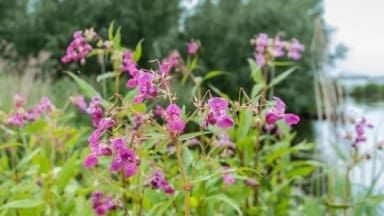
Listed as an invasive non-native plant under the provisions made within Schedule 9 of the Wildlife and Countryside Act 1981, it is an offence to plant or cause Himalayan balsam (Impatiens glandulifera) to grow in the wild. Himalayan Balsam is a tall growing annual, 2-3m (6-10ft) in height, flowering between June and October with bright clusters of purplish pink, helmet-shaped flowers. The flowers are followed by seed pods that open explosively when ripe.
Imported to the UK by Victorian botanists in 1839, the plant has no natural rivals and can quickly dominate ditches and river banks, wiping out indigenous species. Rivers in Gloucestershire (and across the country) are under threat from this invasive plant, which easily outcompetes native plant species for sunlight, space and nutrients.
The Gloucestershire Wildlife Trust (GWT) is now enlisting the help of Gloucester and Cheltenham residents to help them combat Himalayan Balsam throughout June, by means of the Crowdorsa app – whose technology reach means they can offer a financial reward to volunteers.
Via the Crowdsorsa app, or the WilderGlos platform volunteers will can earn up to 25 pence per square meter of Balsam removed. The sightings are recorded before and after eradication, and the videos are uploaded for review.

